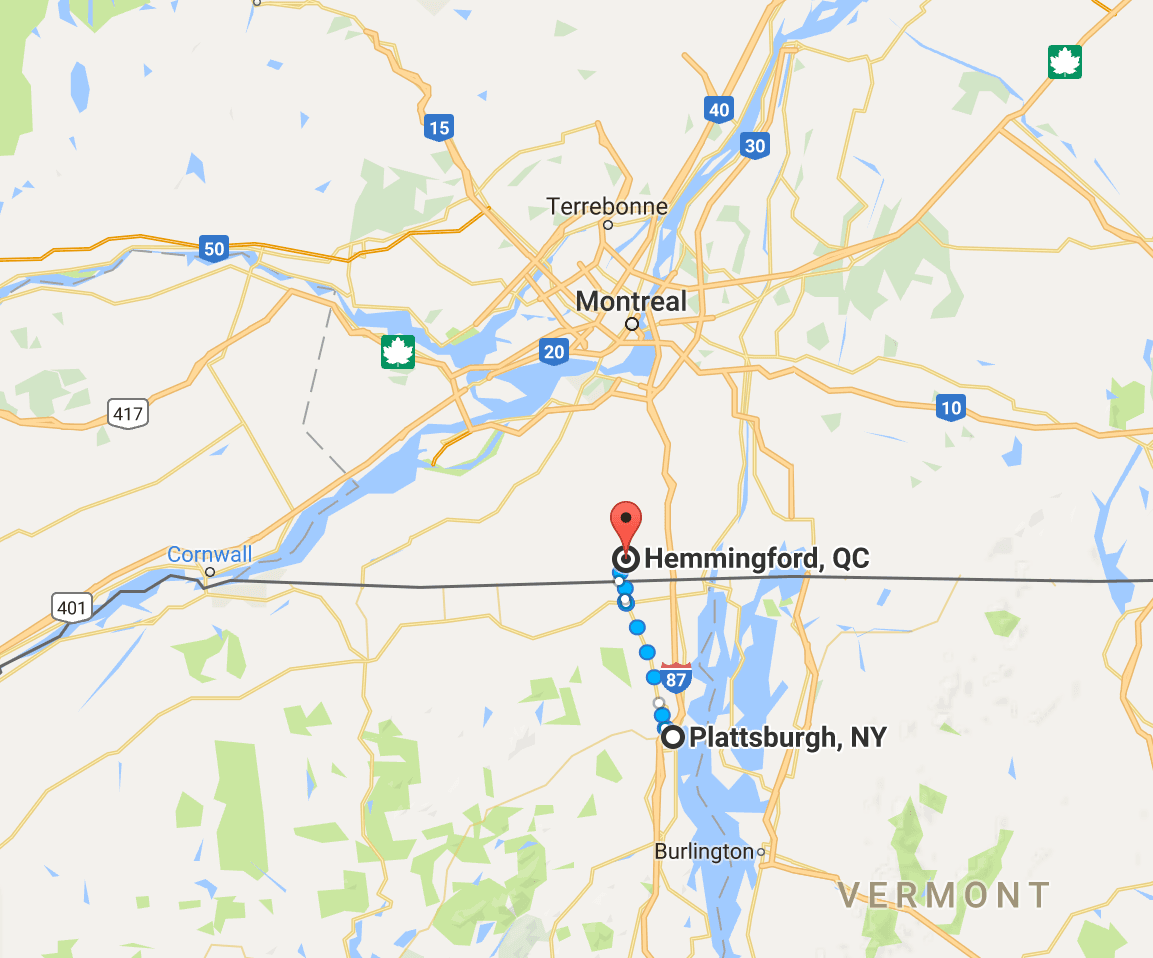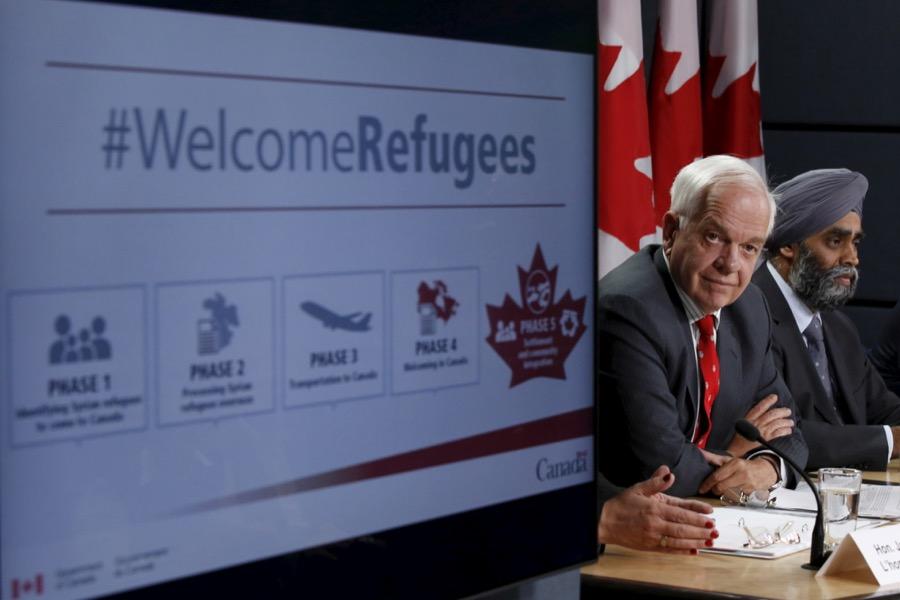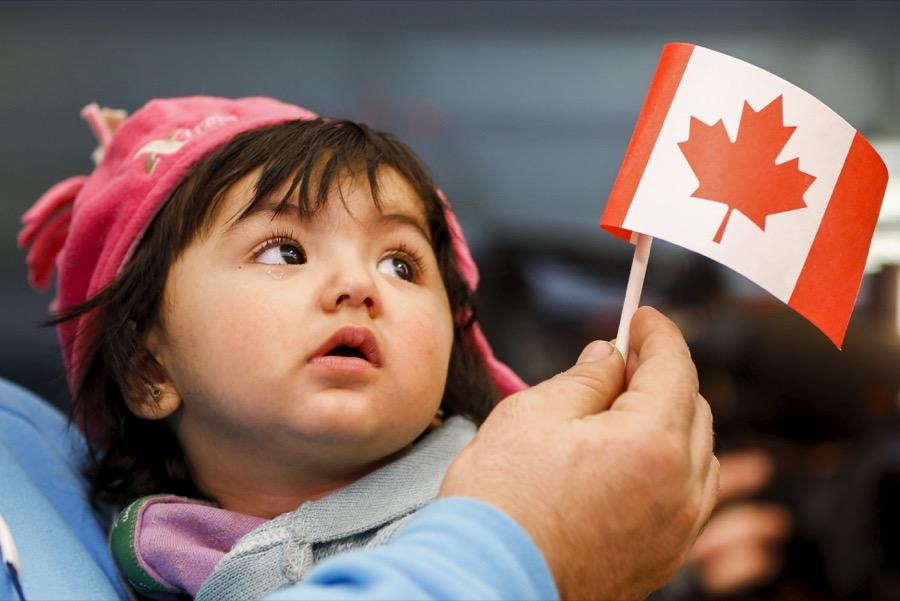Way more migrants are now sneaking across the US-Canada border
A young Syrian refugee looks up as her father holds her and a Canadian flag at the as they arrive at Pearson Toronto International Airport in Mississauga, Ontario, Dec. 18, 2015.
Canadian border officials are spotting a noteworthy trend: The number of people sneaking in from the United States and asking for asylum has gone way up.
One popular route leads into Quebec. Families lug suitcases “over a little ditch,” as one resident described it, to avoid passport checkpoints.
This past year, 1,222 people entered Quebec illegally and requested refugee status — almost five times the total in the previous year, according to the Canada Border Services Agency. The tally in November alone was higher than the whole of 2015.
The authorities won’t say whether Donald Trump’s November election win has anything to do with the surge. “We can’t speculate on that. We can’t speculate on the motives,” says Jacqueline Roby, a spokeswoman for the Canada Border Services Agency.
But some migrant rights advocates say that Trump’s promises to get tough on immigration, coupled with Canada’s reputation for welcoming refugees, could be factors.
Based on data provided to PRI by the Canada Border Services Agency.
Despite repeated efforts to contact the asylum-seekers, officials and nongovernmental groups would not let us speak to them directly because refugee protection claims are private under Canadian law.
According to the data, very few of the asylum-seekers walking across Quebec’s border illegally are US citizens. The largest groups are from Eritrea, Syria, Sudan, Yemen and other countries facing economic or war catastrophe.
Related: A Syrian family finds sweet success in Canada
Retired policeman François Doré lives in Hemmingford, Quebec, less than a mile from the US border. He says he sees refugees from his window every week, sometimes two dozen people in a single day.
“They used to cross at night through the woods, now they just walk over the little ditch and walk into Canada,” he says.

“I know there’ve been some rumors since Donald Trump has been elected, but I haven’t seen any Americans crossing illegally,” Doré says.
However, 187 Americans requested to be admitted as refugees at Canadian land border crossings last year — more than double the previous total, according to Canada’s border agency.
Last year overall, Canadian land-border refugee claims were up 50 percent from 2015. The top five countries of origin in 2016 were Colombia, Syria, Iraq, Eritrea and Pakistan.
What happens to the refugees in Canada
Canadian officials are confident they catch most people entering illegally, thanks to surveillance cameras and reports from residents.
“We catch most of them. At least 90 percent,” asserts Camille Habel, a media representative for Canada’s police, the RCMP. “Often people don’t mind that we find them. They walk on little roads, gravel roads. Some cross in the forest. Eventually they get to places where we can find them.”
Officials check the migrants for injuries or other health conditions like frostbite, Habel says.
“The entrance is illegal, but it’s not a criminal case,” Habel says. “Everyone is well treated, everyone is treated the same as any other human being in Canada. The only reason they can be put in prison is if they had done something illegal like [trying] to smuggle drugs or contraband, or if we find out they’re part of a criminal network.”
Canadian officials can also detain individuals who cannot establish their identity, are determined to be a flight risk, or if there is a security concern.
If someone is put in detention, they have the right to see a judge within 24 hours, Habel says.

After they’re caught, the migrants generally request to be admitted into Canada as refugees. They receive a date to appear before a refugee tribunal, which by law cannot be more than two months away.
Unlike in the US, they don’t have to wait in detention centers for that court date to come.
Related: 20 years ago, asylum-seekers in the US were not automatically put in immigration detention
On average 60 percent of all people who go before the tribunal are granted asylum in Canada, although the acceptance rate varies by country of origin, says Melissa Anderson, the spokeswoman for the Immigration and Refugee Board of Canada.
For instance, the citizens of Syria, Iraq and Eritrea have an acceptance rate of more than 80 percent and are even exempt from appearing before the refugee tribunal in person. They are generally granted asylum in Canada, unless they already have refugee status in another country, Anderson explains.
Members of the Roma minority from Romania and Hungary are also generally accepted, says Stephane Handfield, an immigration attorney in Montreal.
A very low rate of US citizens, on the other hand, win refugee claims in Canada. That’s not including undocumented immigrants who reside in the US and their children who may have been born in the country. Their cases have a higher chance of approval.
The process of being admitted as a refugee once a person is already inside Canada is faster than applying from outside the country. Refugee claims made from outside Canada can take longer than five years to process for some countries, according to the government’s immigration website.
Why do they do it?
So why are people crossing the Canadian border illegally?
One reason is the Canada-US Safe Third Country Agreement, explains Janet Dench, the executive director of the Canadian Council for Refugees, a nonprofit group that advocates for refugee rights.
According to this 2004 agreement, a person who is in the US, which is considered a safe country, cannot request admittance as a refugee into Canada. For example, if someone in America on a tourist visa asks for asylum at a Canadian border crossing, they will most likely be denied. However, if they request refugee status when they’re already on Canadian soil, and pass a criminal check, their case will be considered. So the Safe Third Country Agreement lures asylum-seekers to cross the border into Canada illegally, Dench says.
“That’s the reason we believe the government should pull out of the Safe Third Country Agreement — people could cross legally, and it would take out the market from the smugglers who are taking a huge amount of money from people,” Dench says.
The Trump effect?
What’s more, “the United States is not necessarily safe for all refugees,” Dench adds.
Undocumented immigrants in the US, estimated at 11 million, are particularly vulnerable. Should they try to flee to Canada, it won’t be easy. US border patrol has the authority to take into custody anyone who is in the US illegally who’s caught near the border, according to Stephanie Malin, a public affairs officer with US Customs and Border Protection.
In November, Trump said on the TV show “60 Minutes” that he plans to deport or incarcerate “2 million or 3 million” undocumented immigrants with a criminal record after he takes office on Jan. 20.
Plans like that could be pushing refugees into Canada, says Dench of the Canadian Council for Refugees.
“There are a lot of people who are watching with concern what the election of Trump means to them. Some may think they may not be able to continue safely in the US,” she says. “There could be new movements of people.”
Other refugees pass through the US only briefly on their way to Canada, simply because it’s easier to get American tourist visas than Canadian visas, attorney Handfield says.
“Sometimes they say that Canada is a better country for refugees. Canada accepts more refugees than the US. There is less racism in Canada,” he said.
Whatever the case may be, there is no talk in Canada about building a wall on the American border.
Julie Masis reported from Montreal.
